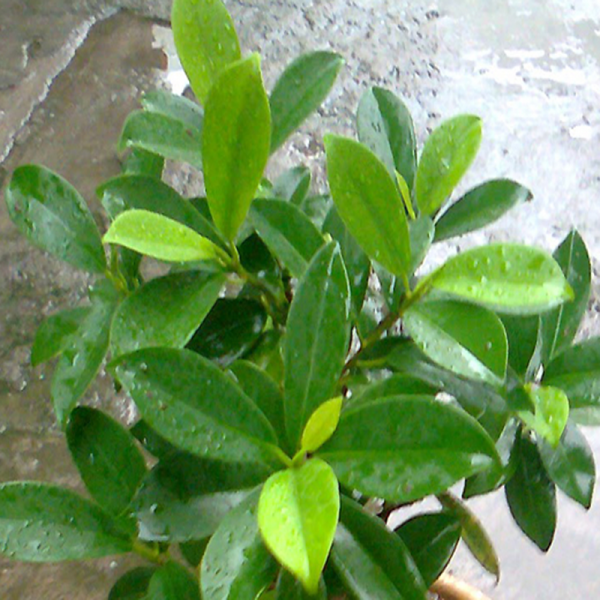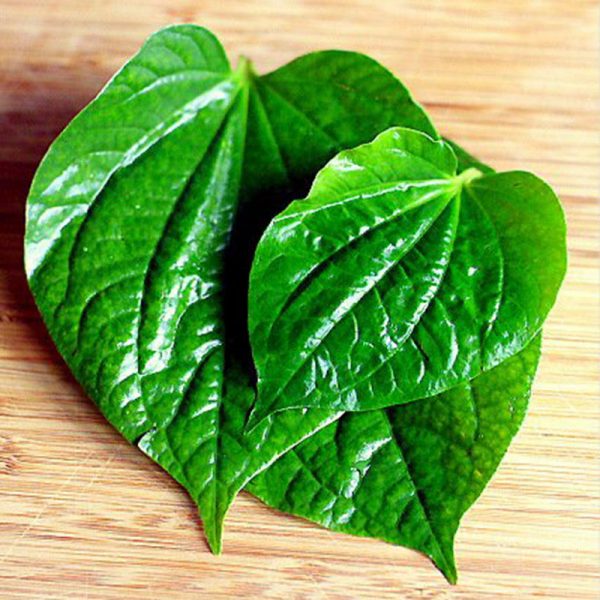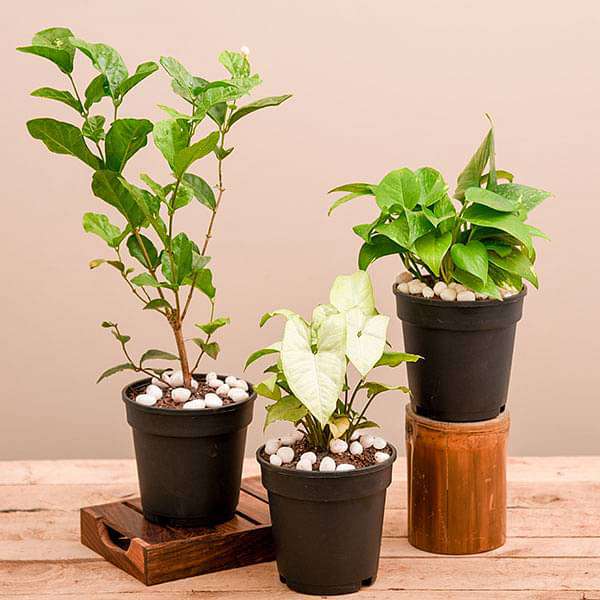Green plants are gorgeous, but sometimes, we crave brighter colors and bold patterns. The aglaonema plant, also known as Chinese evergreen, offers both. This compact, easy-to-grow houseplant is loved for its vibrant coloring and patterns, ranging from jungle green, pink, red, silver, and yellow to stripes, speckles, and gradients. So if your space is in need of a little splash of color, aglaonema is the plant for you.
Aside from the spectacular look of these plants, aglaonema also happens to be easygoing, compact, and best of all, great at communicating its needs, making it an ideal choice for newbie plant parents. It’s also generally slow-growing, meaning you’ll only need to repot every three years or so. However, you’ll need to be extra careful about placement, as aglaonema is toxic to both humans and pets.12
- Botanical Name: Aglaonema commutatum
- Common Name: Aglaonema, Chinese evergreen
- Plant Type: Evergreen perennial
- Mature Size: 20 inches high
- Sun Exposure: Low to bright, indirect light
- Soil Type: Peat-based potting soil
- Soil pH: 5.6–6.5
- Toxicity: Toxic to people; toxic to pets1 2
Plant Care
Keep your aglaonema plant’s soil just barely moist—but not wet—and avoid allowing the soil to dry out completely. Generally, it will need watering more frequently in the spring and summer and less in the winter, so check the soil moisture regularly.
Feed your aglaonema with houseplant fertilizer diluted to half strength every four months or so. When your plant’s pot becomes overcrowded, transplant it into a container one size larger with fresh soil. This is best done during the spring or summer when the plant is actively growing.
Best Growing Conditions for Aglaonema
Many of our favorite houseplants need as much light as you can give them, but aglaonema plants are pretty flexible in this regard. In particular, green varieties of aglaonema can tolerate lower-light conditions well. However, for colorful variegated species, bright, shadowless light is ideal—such as from a window facing north, which offers the weakest light compared to windows with other exposures.
This plant likes the heat, so make sure that you place it in a warm spot, ideally with nights in the 60-degree range and days ranging from 75–85 degrees.
Pot your aglaonema in standard potting soil. Like pothos and heartleaf philodendron, aglaonema can also be kept in a clear container of water. If using this method, add a bit of charcoal to the water, and feed the plant once per month with just a drop of houseplant fertilizer.
Your plant will tell you when it’s getting too dry by letting its leaves droop. They should perk back up shortly after watering. If your plant’s leaves are yellowing or its stems feel mushy, that’s a sign that the plant is getting too much water.
Types of Aglaonema
There are more than 100 varieties of aglaonema to choose from. Cultivars like ‘Red Peacock’, ‘George’s Ruby’, and ‘Harlequin’ have splashes of pink and yellow, while ‘Anyanmanee’ has bright pink leaves speckled and edged with a bit of green.
The green-hued aglaonema, sometimes called Philippine evergreen, offers a lush, jungle-like feel along with more subdued—but no less attractive—colors and patterns. ‘Black Lance,’ a larger cultivar, features long, pointed leaves with pale silver and deep green hues, whereas the pale green and white stripes on A. modestum and ‘Brilliant’ call to mind the coloring of some calathea species.
How to Propagate Aglaonema
Aglaonema is very easy to propagate in water or in soil via stem cuttings. You’ll get the best results with propagation done during the warm growing season. Here’s how:
Step 1: Identify a healthy shoot on the mother plant to remove for your cutting. The shoot should have at least five leaves and be at least 6 inches long. Both newer and older shoots can be used for propagation.
Step 2: Using a clean, sharp blade or gardening shears, make a diagonal cut in the shoot’s stem just below a leaf node. Trim off a couple of bottom leaves from the cutting.
Step 3: If using the water method, fill an appropriately-sized glass or jar with water so that the leaf nodes (but not the remaining leaves) will be submerged, and place the cutting in the water.
Water-propagated specimens tend not to thrive when planted in soil. If you choose to propagate in water, it’s best to keep the mature plant in water, too.
Step 4: If using the soil method, fill a small plant container with well-draining potting soil. Moisten the soil, poke a hole a few inches deep with your finger or a pencil, and plant the cutting in the soil. Pat the soil gently around the base of the cutting to secure it.
Step 5: Place your cuttings in a warm place with bright, indirect light. If using the water method, change the water when it becomes cloudy. The plant should establish new roots in four to six weeks. After that point, care for the new plant as usual.
Common Problems With Aglaonema
Caring for Aglaonema is relatively simple. Luckily, these plants are great communicators if you keep your eyes open, so you’ll be able to easily spot common growing issues.
Dry Leaf Tips
One indicator that there’s a growing problem with your aglaonema is dried-out leaf tips. This is called “tipping,” and it can be a symptom of a few issues, including overwatering and too much fertilizer. Professional gardeners have determined that the most common cause of tipping is watering your plant with water that has a high concentration of salts, chlorine, and fluoride. If your plant is showing signs of tipping, switch to purified water.
Drooping Leaves
This is one of those instances where your aglaonema is telling you exactly what it needs. Drooping leaves means your plant is very thirsty, so give it a big drink of water and keep a closer eye on it to prevent the soil from drying out completely.
Yellow Leaves
If your plant’s leaves are turning yellow, that usually means you’re overwatering. Take it easy on the water level and let the soil dry out more in between. On the other hand, if your aglaonema leaves are both yellow and drooping, that’s a sign that your plant is really thirsty, so give it a nice long drink and adjust your watering schedule accordingly.
Potting and Repotting Aglaonema
Chinese evergreens don’t mind being a little rootbound, but once your plant becomes too crowded with roots poking out of the drainage holes, that means it’s time to transplant. This is best done during the spring or summer when the plant is actively growing.
Choose a pot that’s 3 to 4 inches wider than the current container and line it with fresh soil. Gently loosen your plant around the edges with your hand or a slim garden trowel and wiggle it free from the container. Place it in the new pot, top with fresh soil, and give it a nice drink of water.
How to Get Aglaonema to Bloom
With plenty of bright, indirect light, it is possible that your aglaonema will send out flowers. Much like the Peace Lily or Anthurium, these flowers form a thin spadix surrounded by a leafy spathe. At first, you may think a new leaf is unfurling, but you’ll soon see that it’s a unique flower. While it’s incredibly rewarding to see your plant so happy, generally Chinese evergreens are enjoyed for their lush foliage, so you don’t need to put too much effort into trying to get yours to bloom.
FAQs
Are aglaonema easy to care for?
Absolutely. Chinese evergreens are some of the most rewarding houseplants out there—bright and beautiful foliage with minimal effort. Plus, they’re beginner and low-light friendly.
How fast does aglaonema grow?
While some varieties grow faster than others, Aglaonema are generally slow-growing plants that produce more leaves in the summer and very few (if any) in the winter. Because of this, you’ll only need to repot once every three years or so.
What is the difference between aglaonema and dieffenbachia?
These two get mixed up quite often. They’re both lush, leafy plants prized for their unique foliage. The main difference will be in mature size—aglaonema top out at one to two feet, while dieffenbachia can get much larger. Aglaonema leaves also tend to have bolder and more random leaf variegations, while dieffenbachia leaves usually have a lighter shade inside and a darker shade outside.






Reviews
There are no reviews yet.